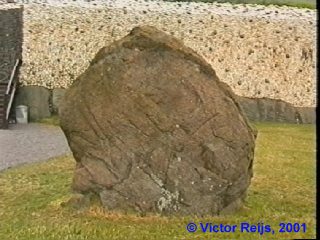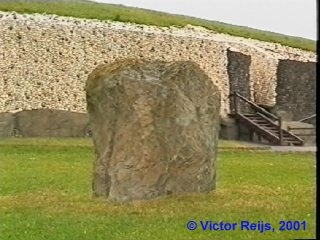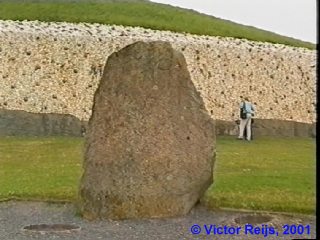 Home
Home Up
Up Search
Search Mail
Mail
NEW
Equinox at megalithic buildings in Ireland
Equinox, east, west are words we understand in present days. What they
represented and how they were represented 5000 years ago we don't know.
Some megalithic buildings seem to be aligned to periods around equinox
such as Cairn T at Loughcrew, Knowth
with its two passages (one easterly and one westerly) in the Boyne
valley and many more.
10 years ago I was fascinated by the (now invisible) area
in front on the Newgrange passage; the oval setting, the hut and
the
bank of yellow boulder clay. Knowth has comparable round settings as
Newgrange
in front of its two passages.
Settings
My mind took some 10 years to grind on this and it realizes now that
there
could be an important link between these round/oval settings (covered
with
quartz stones) near the passages entrances and more in particular the
kerb
stones in front of the passages!
Knowth
Looking at Knowth, the round settings are in front of the passages and
they have a standing stone, which shadows align with the vertical lines
on resp. kerb stone K11 and K74 around equinox days. The vertical line
and the standing stone act as sun dial to announce equinox (if it is
precisely
equinox, I don't know after all the excavations). This possible
alignment
is quiet obvious in my opinion and already noted by more people.
Remember thought, these alignments will be difficult to prove, because
both the standing stones and the kerb stones have been moved and
relocated,
so the question is if they are still at the correct location!
Newgrange
At Newgrange this took me some more time! But if you stand in the oval
setting (it is now covered up by sand and grass) you can cast a shadow
at equinox sun rise days which aligns with the carved vertical line on
kerb stone K1. There was no standing stone found during the excavations
of the oval setting, but a small phallus like stone laying almost
east-west
(O' Kelly, figure 9). If one would
place
a staff or standing stone at that location, its shadow will align with
the vertical line of K1.
Or is the triangular stone shown in Vallancey picture the standing
stone
on the oval setting?

But I have some problems in identifying the stones. If we number
Vallancey
stones from left to right with A, B, C and D, then I think the
following
mapping evolves (if you have other ideas, let
me know):
- A, this stones looks to be the front view of GC-1

- B, this stones looks to be GC3

- C, this stone looks to be the side view of GC-1

- D, this stone looks to be the side view of GC-2

The stones are of course seen in a different view when looking at
Vallancey
drawing. Here is a photo from the possible standpoint of him:

Cairn T
Cairn T had also a round/oval setting with quart stones in front of the
passage (according to O'Kelly, page 76).
I have not seen a picture where this setting was at Cairn T.
Furthermore
there is not a kerb stone with a vertical carved line like at Knowth
and
Newgrange. So any information is welcome
here!
Conclusion
Is this a coincidence? In my opinion: This could be a new clue why
these
vertical lines are present!
So why a pronounced vertical line on K52 of Newgrange? Was there also
a setting on the north side of Newgrange (equinox sunset)? Could it be
under the not yet unexcavated part on the north side? Perhaps time will
learn.
Another way of finding equinox
The horns of the solstice picture
(like made by Charles Ross and
also referred to by Brennan [1983] page
190),
provides an interesting idea for equinox. Calculating this picture;
using Latitude 53 degrees, a vertical sundial gnomon of 1 meter and
around 2000 CE one gets the below:
(horizontal: time of day [hour],
vertical: length of shadow [m] in North direction)
This straight form of the line at equinox time is independent of the
latitude! This straight line at equinoxes is thus very interesting;
would this have been used in former times to determine equinox?
Some modern sundials also provide lines
of declinations and thus
these horns.
Disclaimer and Copyright
 Home
Home Up
Up Search
Search Mail
Mail
Major content related changes: July. 29, 2001






